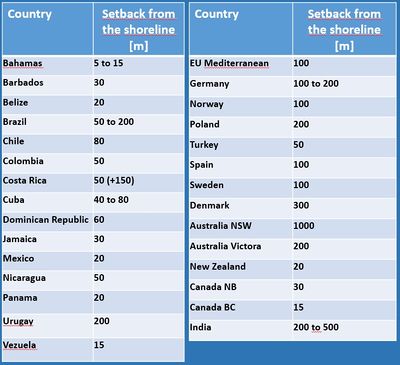Setback area
Definition of Setback area:
A strip along the coastal zone, where certain development activities are prohibited or significantly restricted[1].
This is the common definition for Setback area, other definitions can be discussed in the article
|
The setback area is delimited by setback lines, the distance from the shoreline (generally the high-water line, sometimes the dunefoot or first vegetation line) where private hard constructions are prohibited. Setback lines are a popular coastal zone planning instrument in many countries, see Table 1. Although these setback lines are laid down in coastal regulations, they are often poorly enforced in practice. Moreover, they are rarely based on a statistical analysis of extreme conditions and in that case they do not offer any guarantee of flood protection.
Equivalent provisions for coastal development exist in some other countries. In the Netherlands, for example, private building is forbidden in the coastal defense zone (beach, seadike, first dune row). In addition, building in the coastal dune belt is prohibited under the European NATURA directives.
References
- ↑ Mangor, Karsten. 2004. “Shoreline Management Guidelines”. DHI Water and Environment, 294pp.
- ↑ Simpson, M.C., Mercer Clarke, C.S.L., Clarke, J.D., Scott, D. and Clarke, A.J. 2012. Coastal Setbacks in Latin America and the Caribbean; A Study of Emerging Issues and Trends that Inform Guidelines for Coastal Planning and Development Inter-American Development Bank VPS/ESG TECHNICAL NOTE No. IDB - TN - 476
- ↑ Rochette, J. and R. Billé. 2010. Analysis of the Mediterranean ICZM Protocol: At the crossroads between the rationality of provisions and the logic of negotiations. Institute for Sustainable Development and International Relations (IDDRI). Paris. 62 pp.
